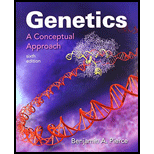
a.
To determine:
The probability that another child of the couple will have retinoblastoma.
Introduction:
Alfred Knudson in 1971, proposed a model to explain the genetic basis for cancer. He was studying retinoblastoma (develops in one eye but sometimes appears in both) and proposed that retinoblastoma results from separate genetic defects mainly two and both of which are required for the development of cancer. Mutations in the cells of a single eye results in “unilateral retinoblastoma” which is common and can occur to a normal person.
Mutations in the cells of both eyes result in “bilateral retinoblastoma” which is rare and cannot happen randomly like unilateral retinoblastoma. Individuals inherit the only single mutation from suffering relatives and if the second mutation occurs in any of these cells then it would result in bilateral retinoblastoma.
b.
To determine:
Whether the next child has unilateral or bilateral retinoblastoma.
Introduction:
Alfred Knudson in 1971, proposed a model to explain the genetic basis for cancer. He was studying retinoblastoma (develops in one eye but sometimes appears in both) and proposed that retinoblastoma results from separate genetic defects mainly two and both of which are required for the development of cancer. Mutations in the cells of a single eye results in “unilateral retinoblastoma” which is common and can occur to a normal person.
Mutations in the cells of both eyes result in “bilateral retinoblastoma” which is rare and cannot happen randomly like unilateral retinoblastoma. Individuals inherit the only single mutation from suffering relatives and if the second mutation occurs in any of these cells then it would result in bilateral retinoblastoma.
c.
To determine:
The reason corresponding to that father has unilateral retinoblastoma while in his son’s and brother’s case it is bilateral retinoblastoma.
Introduction:
Alfred Knudson in 1971, proposed a model to explain the genetic basis for cancer. He was studying retinoblastoma (develops in one eye but sometimes appears in both) and proposed that retinoblastoma results from separate genetic defects mainly two and both of which are required for the development of cancer. Mutations in the cells of a single eye results in “unilateral retinoblastoma” which is common and can occur to a normal person.
Mutations in the cells of both eyes result in “bilateral retinoblastoma” which is rare and cannot happen randomly like unilateral retinoblastoma. Individuals inherit the only single mutation from suffering relatives and if the second mutation occurs in any of these cells then it would result in bilateral retinoblastoma.
Want to see the full answer?
Check out a sample textbook solution
Chapter 23 Solutions
Genetics: A Conceptual Approach 6E w/ SaplingPlus (Six-Month Access)
- In one paragraph show how atoms and they're structure are related to the structure of dna and proteins. Talk about what atoms are. what they're made of, why chemical bonding is important to DNA?arrow_forwardWhat are the structure and properties of atoms and chemical bonds (especially how they relate to DNA and proteins).arrow_forwardThe Sentinel Cell: Nature’s Answer to Cancer?arrow_forward
- Molecular Biology Question You are working to characterize a novel protein in mice. Analysis shows that high levels of the primary transcript that codes for this protein are found in tissue from the brain, muscle, liver, and pancreas. However, an antibody that recognizes the C-terminal portion of the protein indicates that the protein is present in brain, muscle, and liver, but not in the pancreas. What is the most likely explanation for this result?arrow_forwardMolecular Biology Explain/discuss how “slow stop” and “quick/fast stop” mutants wereused to identify different protein involved in DNA replication in E. coli.arrow_forwardMolecular Biology Question A gene that codes for a protein was removed from a eukaryotic cell and inserted into a prokaryotic cell. Although the gene was successfully transcribed and translated, it produced a different protein than it produced in the eukaryotic cell. What is the most likely explanation?arrow_forward
- Molecular Biology LIST three characteristics of origins of replicationarrow_forwardMolecular Biology Question Please help. Thank you For E coli DNA polymerase III, give the structure and function of the b-clamp sub-complex. Describe how the structure of this sub-complex is important for it’s function.arrow_forwardMolecular Biology LIST three characteristics of DNA Polymerasesarrow_forward
 Human Anatomy & Physiology (11th Edition)BiologyISBN:9780134580999Author:Elaine N. Marieb, Katja N. HoehnPublisher:PEARSON
Human Anatomy & Physiology (11th Edition)BiologyISBN:9780134580999Author:Elaine N. Marieb, Katja N. HoehnPublisher:PEARSON Biology 2eBiologyISBN:9781947172517Author:Matthew Douglas, Jung Choi, Mary Ann ClarkPublisher:OpenStax
Biology 2eBiologyISBN:9781947172517Author:Matthew Douglas, Jung Choi, Mary Ann ClarkPublisher:OpenStax Anatomy & PhysiologyBiologyISBN:9781259398629Author:McKinley, Michael P., O'loughlin, Valerie Dean, Bidle, Theresa StouterPublisher:Mcgraw Hill Education,
Anatomy & PhysiologyBiologyISBN:9781259398629Author:McKinley, Michael P., O'loughlin, Valerie Dean, Bidle, Theresa StouterPublisher:Mcgraw Hill Education, Molecular Biology of the Cell (Sixth Edition)BiologyISBN:9780815344322Author:Bruce Alberts, Alexander D. Johnson, Julian Lewis, David Morgan, Martin Raff, Keith Roberts, Peter WalterPublisher:W. W. Norton & Company
Molecular Biology of the Cell (Sixth Edition)BiologyISBN:9780815344322Author:Bruce Alberts, Alexander D. Johnson, Julian Lewis, David Morgan, Martin Raff, Keith Roberts, Peter WalterPublisher:W. W. Norton & Company Laboratory Manual For Human Anatomy & PhysiologyBiologyISBN:9781260159363Author:Martin, Terry R., Prentice-craver, CynthiaPublisher:McGraw-Hill Publishing Co.
Laboratory Manual For Human Anatomy & PhysiologyBiologyISBN:9781260159363Author:Martin, Terry R., Prentice-craver, CynthiaPublisher:McGraw-Hill Publishing Co. Inquiry Into Life (16th Edition)BiologyISBN:9781260231700Author:Sylvia S. Mader, Michael WindelspechtPublisher:McGraw Hill Education
Inquiry Into Life (16th Edition)BiologyISBN:9781260231700Author:Sylvia S. Mader, Michael WindelspechtPublisher:McGraw Hill Education





